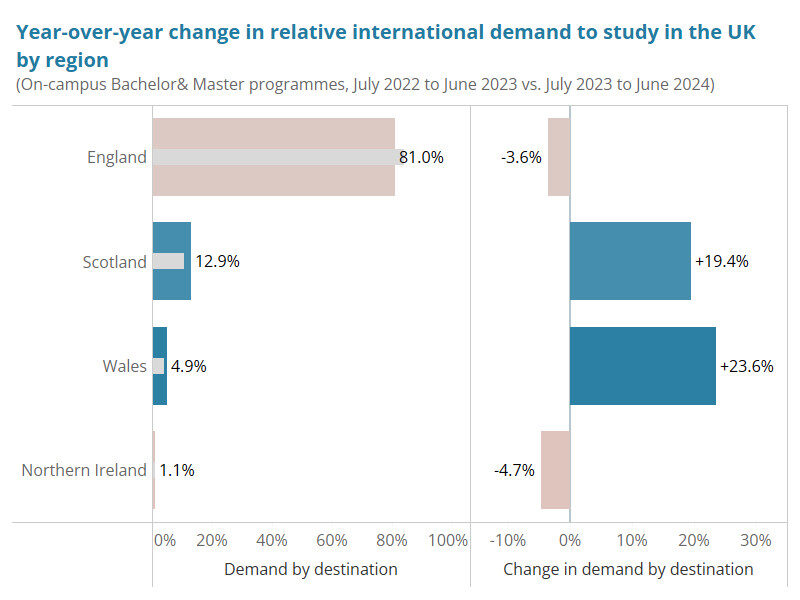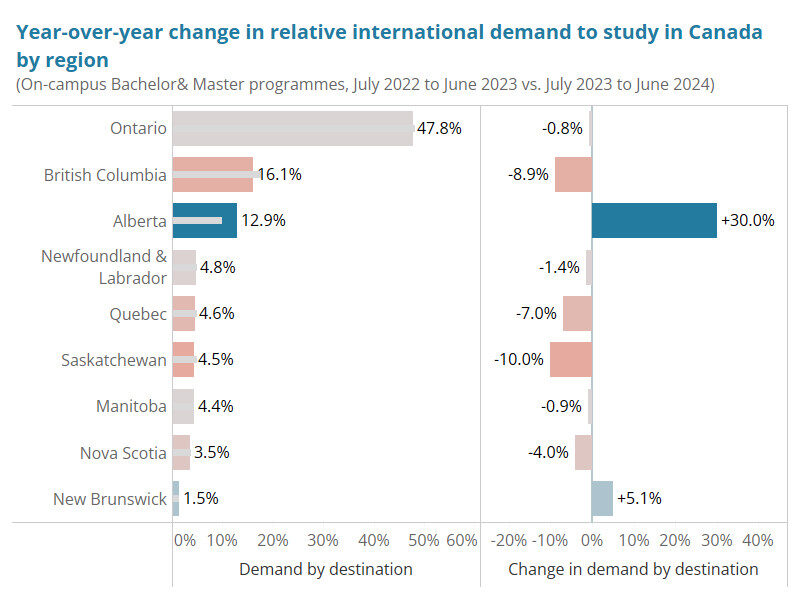Winners & Losers: An update on how domestic policies in the UK, Canada, and Australia have impacted student search behaviour


How are policies restricting international student mobility affecting student demand for popular study destinations like the UK, Canada, and Australia? In this article we provide an update on these developments to highlight how each destination is faring in terms of student demand, including by observing our data on a regional level for each destination alongside origin student demand.
The high level view
The figure below illustrates the trend in weekly pageviews generated by prospective students on Studyportals websites throughout 2024. It indicates how demand from prospective students for on-campus Bachelor or Master programmes offered in these destinations was rising at the start of the year, which may be attributed to students seeking to secure a place to study abroad.
However, by February student demand already started to decline in the UK and rapidly so for Canada by the end of this month, whilst demand for Australia gradually declined. Compared to the first week of 2024, the UK, Australia, and Canada respectively saw a drop of 25.8%, 25.1%, and 17.6% by 21st July 2024, indicating the strong shift away of prospective students seeking to study in these countries.
That being said, it is also worth noting how the UK has recently witnessed an uptick in student demand, perhaps influenced by the recent elections that saw the Labour party replace the Conservative party that had implemented policies concerning dependent visas of international students studying in the UK.

If we were to look at the year-over-year change in international student demand per region of each study destination then there are certain points worth noting.
While the UK’s policies can be considered to have damaged its reputation as a top destination for international students, institutions based in England witnessed only a modest decline in student demand in the last 12 months (July 2023 to June 2024) compared to the previous 12 months (July 2022 to June 2023). Meanwhile, those in Scotland and Wales have seen credible increases in demand during the same time period.

The same cannot be said for Canada and Australia, where several domestic regions have respectively seen significant drops in international student demand, such as Saskatchewan, British Columbia, Quebec in Canada and the Southern, Western, and Victorian regions of Australia. Only with regard to Alberta in Canada and both New South Wales and the Northern Territory in Australia was there a noticeable rise in demand.


Origins behind the decline
The figure below instead considers the year-over-year change in relative demand from the top-5 origin countries generating the most international student demand for each destination. It is immediately visible that Canada has experienced a consistent decline in demand from each top origin, especially from India and Iran, which is somewhat similar to the UK but to lesser extent.
In the case of the UK, Nigerian demand has significantly dropped, which may be due to the combination of the UK’s policies and the economic difficulties Nigerian currently face. Meanwhile, Australia has seen a notable drop in Pakistani demand, alongside modest decreases from Sri Lankan and Nepalese users.

Lastly, by observing where prospective students from India, Pakistan, Iran, Bangladesh, and Nigeria are looking to study instead of the Australia, Canada, and the UK, then Studyportals data again reveals some interesting points. For instance, on-campus Bachelor and Master’s US programmes witnessed a rise in student demand from each origin country in the last 12 months, alongside Italy and Germany as alternative destinations in Europe.
It is also worth noting that although Bangladeshi students also consider Italy and Germany, there has been a drop in demand over the last 12 months compared to the previous 12 months. Lastly, in the case of Nigeria, it remains the case that Austrian institutions are an appealing alternative for these students, a trend that was first identified across several data platforms towards the end of 2023.

The road ahead
As a result of the data shown above, it is clear that the international student landscape has been impacted by the domestic policies in the UK, Canada, and Australia. While the UK may be experiencing a modest recovery in student demand due to recent political changes, Canada and Australia continue to see more pronounced declines.
Meanwhile, the US, alongside European countries like Italy and Germany, have emerged as increasingly attractive alternatives for international students from key recruitment markets in South Asia, Iran, and Nigeria. These trends, in short, underscore how a destination’s flexible and welcoming policies make or break a country’s appeal as a study destination for prospective students. As the global higher education market continues to evolve, these insights offer valuable guidance for policymakers and educational institutions aiming to attract and retain international talent, but also highlight the opportunities that other destinations currently have in taking advantage of the clear shift in student demand seen over the last 12 months.


